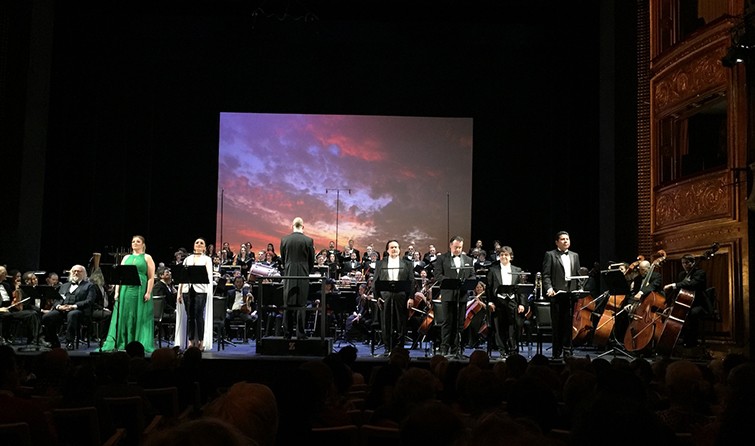
El Teatro de la Zarzuela continua con su labor de rescate de ese patrimonio musical español tan poco valorado. En esta ocasión, y tras Maruxa, llega «La tempestad». Obra del maestro Ruperto Chapí que fue estrenada en la Zarzuela el 11 de marzo de 1882. Durante veinte años se programó con regularidad antes de desaparecer, hasta el día de hoy. Una de las principales razones de esta ausencia sobre los escenarios puede estar en la necesidad que tiene esta obra, debido a sus exigencias vocales, de seis grandes intérpretes. Y aquí está el primer esfuerzo y acierto del Daniel Bianco, director del Teatro de la Zarzuela. Ha reunido para esta tempestad nada menos que a Carlos Álvarez, José Bros, Mariola Cantarero, Ketevan Kemoklidze, Carlos Cosías y Alejandro López.
El siguiente desafío ha venido de la necesidad de ofrecer La tempestad en versión concierto pues, como el propio Bianco afirma “no siempre disponemos del presupuesto o el tiempo suficiente para programar lo que queremos”. Pero, ¿cómo se hace una zarzuela en versión concierto? Los diálogos en escena que caracterizan este género, en el que no solo se canta, carecen de sentido en una versión de concierto. Y este punto también ha sido bien resuelto por Bianco. Se encargó al reconocido dramaturgo Alberto Conejero una versión del texto de Miguel Ramos Carrión. El resultado no ha podido ser más eficaz. Conejero ha trasladado el peso explicativo de los diálogos a un narrador, al mejor posible. Juan Echanove cuenta la historia desde el interior de uno de los personajes, Mateo. Y lo hace creando una atmósfera dramatúrgica en la que la escenografía aparece ante el espectador sin necesidad de más elementos que su voz y su forma de narrar, “No es recitar, no es interpretar, no se de que manera pero tengo que cantarlo”. Y su voz suena a música al lado del resto del reparto.
Para completar los aciertos de esta tempestad se ha contado con el mayor experto chapiniano en la actualidad, el director Guillermo García Calvo. Una partitura como esta, que tiene ya las influencias musicales de la época y que se detectan claramente en alguno de sus pasajes, requiere de un exacto conocimiento y lectura. El inicio de la obra presenta efectos instrumentales inspirados en Wagner, concretamente en el Holandés errante, con sus trémolos de cuerda y sus relámpagos. El saxofón, una novedad en ese momento, es claramente de influencia francesa. Como las arias de inspiración verdiana del barítono o del sexteto final. Todo ello sin que deje de reconocerse una partitura musical muy española. Este, junto con la capacidad teatral de Chapí, son los valores que García Calvo ha sabido leer en esta partitura y ha conseguido de la Orquesta un sonido homogéneo, lleno de detalles y de fluidez entre orquesta, narrador y cantantes.
Carlos Álvarez interpreta al malvado Simón en esta misteriosa zarzuela. Sus generosos y profundos graves crearon el Simón que evoluciona hacia el tormento que el autor describe. El barítono se encuentra en un momento vocal extraordinario. Su timbre verdiano es como un guante de seda en esta obra. El público vibró con su interpretación.
El tenor José Bros, como Beltrán, demostró la calidad de su instrumento desde su primera aria, “Salve costa de Bretaña”. La extraordinaria agilidad de su voz, aunque dice estar más cerca ya del tenor lírico que del lírico ligero, sigue intacta. Sedujo con su timbre pulido y un fraseo y línea de canto excepcional.
Teníamos ganas de volver a escuchar en la Zarzuela a Mariola Cantarero. Su personaje de Ángela, hijastra del malvado Simón, estuvo cargado de intención y delicadeza. Su timbre cálido y la elasticidad de su voz para filar y crecer hicieron las delicias del público.
La mezzosoprano Ketevan Kemoklidze es la primera georgiana que canta en el Teatro de la Zarzuela. Cada vez es más habitual que cantantes extranjeros se interesen por nuestro repertorio. Interpreta el personaje de Roberto y lo llena de nobleza y fuerza interpretativa.
El tenor Carlos Cosías es Mateo. Un joven vivaz que Cosías interpreta con decisión, gracia y buen gusto, y una dicción envidiable.
El bajo mexicano Alejandro López da vida al juez que, con toda solemnidad, se encarga de desvelar los misterios de la obra.
Otro personaje principal de esta tempestad es el coro. Chapí maneja muy bien en todas sus partituras la parte coral. En esta obra describe todo el ambiente dramático y adquiere un papel protagonista interactuando con los cantantes, sobre todo acompañando los concertantes que fueron ovacionados por un público a esas alturas entregado. Siempre empastado y mostrando en el coro de mujeres el optimismo que reina después de la tempestad.
